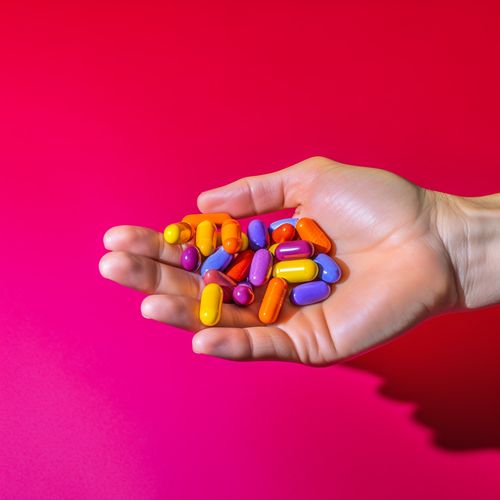Antibiotics are medications that kill bacteria and are used to treat bacterial infections. They can be used on any type of bacterial infection ranging from conditions as minor as acne to those as serious as pneumonia.
However, antibiotics have no effect on viral, fungal, or other types of infections. Using antibiotics for infections other than bacterial contribute to antibiotic resistance and should not be used in these cases.
One of the biggest concerns with overuse and misuse of antibiotics is the development of antibiotic resistance. When bacteria are exposed to antibiotics too frequently or incorrectly, they can adapt and become resistant to that specific antibiotic. This means the antibiotic will no longer be effective in treating the infection caused by the resistant bacteria.
Antibiotic resistance is a global health threat, and it can lead to longer hospital stays, higher healthcare costs, and even death. It is therefore important to only use antibiotics when absolutely necessary and to use them correctly.
In addition, it is important to complete the full course of antibiotics as prescribed by a healthcare professional, even if symptoms improve before the medication is finished. Stopping antibiotics too soon can lead to the surviving bacteria becoming resistant and potentially causing a more severe infection in the future.
How Are Antibiotics Taken?
If you have been prescribed an antibiotic, you should follow your doctor’s or pharmacist’s instructions.
Antibiotics are available in multiple forms:
Orally — Antibiotics can be taken by mouth as a tablet, pill, capsule, or liquid. These antibiotics can be used for most infections.
Topically — Antibiotics can be applied to the skin in a lotion, cream, spray, or drops to treat skin infections.
Intravenously or intramuscularly — When an infection is very serious or life-threatening, antibiotics can be injected directly into the muscle or infused directly into the blood.
You will probably start feeling better after a couple of days on antibiotics, but it is still important to finish the prescribed course until your doctor tells you otherwise. If you do not finish the course, some bacteria may survive and can become resistant to the antibiotic. If this happens, the infection can return, and may be harder to treat.
If You Miss a Dose
If you are late taking your antibiotic, take it as soon as you can, then continue the rest of the course as normal.
If you forget until it is nearly time for the next one, either skip it and take the next scheduled dose or go ahead and take your next dose early. However you handle it, do not make up for a missed dose by doubling up.
If you take two doses of an antibiotic too close together, you may be more likely to experience side effects.
If You Accidentally Take Too Much
Taking an extra dose will probably not cause you any harm, but could increase side effects such as abdominal pain, nausea, or diarrhoea.
If you experience severe side effects, take more than one extra dose, or have any other concerns regarding your antibiotic, call your doctor or NHS 111 immediately.
Types of Antibiotics
Since the discovery of penicillin in 1897, hundreds of different antibiotics have been developed. Most antibiotics fall into one of the following six categories:
Penicillin — These antibiotics are used to treat many infections, including those of the skin, respiratory system, and urinary tract.
Cephalosporins — Most often used to treat very serious infections such as septicaemia and meningitis, though can be used for a variety of infections.
Aminoglycosides — Typically reserved for very serious illnesses such as septicaemia. Antibiotics in this family can have very serious side effects such as hearing loss and kidney damage. These antibiotics are metabolised quickly in the digestive tract, so are most often given as an injection, though they can be given as drops for eye or ear infections.
Tetracyclines — These antibiotics are most often used to treat moderate or severe acne and rosacea, which can cause flushing and spots on the skin.
Macrolides — These antibiotics are especially effective in treating respiratory infections. They are also useful for patients who are allergic to penicillin or to treat infections caused by penicillin-resistant bacteria.
Fluoroquinolones — These are broad-spectrum antibiotics used for a variety of infections.
Recent Changes in Antibiotic Access and Prescribing
In 2024, there have been significant changes in how patients in England can access antibiotics for certain common conditions. The NHS has introduced the Pharmacy First scheme, which allows pharmacists to assess and treat seven specific ailments without the need for a GP appointment. This initiative aims to improve access to care and reduce pressure on general practitioners.
Under this scheme, pharmacists can now consult with patients and prescribe antibiotics when appropriate for the following conditions:
- Sore throat
- Earache
- Sinusitis
- Impetigo
- Shingles
- Infected insect bites
- Uncomplicated urinary tract infections in women
This approach brings England more in line with similar services already available in Scotland, Wales, and Northern Ireland. Patients can access this service by walking into a participating pharmacy or through referrals from NHS 111, urgent treatment centres, emergency departments, or their GP.
It’s important to note that this change doesn’t mean antibiotics will be given out more freely. Pharmacists follow strict protocols for each condition, which include providing information, advice, and symptom relief before considering antibiotics. The NHS is closely monitoring the scheme to ensure it doesn’t contribute to antibiotic resistance.
The Pharmacy First scheme represents a significant shift in how minor ailments are managed in primary care. It offers several benefits:
- Quicker access to treatment for patients
- Reduced pressure on GP services
- Utilisation of pharmacists’ expertise
- Potential for earlier intervention in bacterial infections
However, patients should remember that many of these conditions often resolve on their own or with over-the-counter treatments. Antibiotics are not always necessary or appropriate. The pharmacist’s role includes educating patients about when antibiotics are needed and when alternative treatments might be more suitable.
While this change increases access to antibiotics for specific conditions, it’s crucial to maintain responsible use. Patients should still follow all instructions carefully, complete the full course of antibiotics if prescribed, and never share antibiotics with others or use leftover medications.
As antibiotic resistance remains a global health concern, initiatives like Pharmacy First aim to balance improved access to care with the need for antibiotic stewardship. By consulting with a healthcare professional – whether a pharmacist or a GP – patients can ensure they receive the most appropriate treatment for their condition while contributing to the broader effort to preserve antibiotic effectiveness for future generations.
Side Effects of Antibiotics
Just like any other medication, antibiotics may have some side effects. The most common ones are:
- nausea
- vomiting
- indigestion
- diarrhoea
In most cases antibiotics do not cause a problem, provided they are used as directed. Serious side effects are rare, but some people can have an allergic reaction. The most common antibiotic allergies are penicillin and cephalosporins. Rarely, serious allergic reactions including anaphylaxis can result, requiring immediate medical treatment in a hospital.
Considerations and Interactions
If you are pregnant, breastfeeding, or have certain medical conditions, some antibiotics may not be suitable. Be sure your doctor knows of all of your medical conditions, including if you are pregnant or breastfeeding, before taking any antibiotic to be sure it is safe.
Never take antibiotics prescribed for someone else. Not only could you experience unexpected side effects, the antibiotic may not be effective for your condition.
Some antibiotics can interact with some medications with unexpected results. Oral contraceptives, in particular, may be rendered less effective during the course of antibiotics. Be sure to talk to your doctor about any other medications you are taking and read the information provided with your medication carefully. You might also consider using backup contraception until a few days after finishing your antibiotic if you do not wish to become pregnant.
Resistant Bacteria
Health organisations around the world are working to reduce the use of antibiotics, especially in inappropriate situations. These include conditions not caused by bacteria and minor conditions that are easily handled by the body’s own immune system. This is an effort to fight antibiotic resistant bacteria, which occurs when bacteria mutate and are no longer affected by certain antibiotics.
The body is host to trillions of bacteria, most of them harmless or even beneficial. Antibiotics kill off many of these bacteria, both good and bad. When antibiotics are taken inappropriately, or when they are discontinued early, some of the harmful bacteria survive. You can think about the surviving bacteria, because it has been exposed to the antibiotic but not killed by it, as having been inoculated against it. The bacteria mutates so that it is more likely to survive that antibiotic later. Because antibiotics kill many of the good bacteria as well as the bad, the now-resistant harmful bacteria is better able to multiply and thrive.
There are other factors involved in the resistance of bacteria, but overuse of antibiotics and antibacterial products has been one of the primary factors. This has led to the proliferation of so-called “superbugs”, which are strains of bacteria that are resistant to many antibiotics. Some of these superbugs are well known, including MRSA (methicillin resistant Staphylococcus aureus) and C. diff (Clostridium difficile), and some that are less well known, including multidrug resistant tuberculosis (MDR-TB) and Carbapenemase-producing Enterobacteriaceae (CPE).
These infections are becoming increasingly difficult to treat and the rates of death and disability from these infections are increasing worldwide. The World Health Organisation estimates that MDR-TB alone causes 170,000 deaths every year.
Photo Credit: Zoom Health
Zoom Health is a leading UK supplier of Home Health Tests and Earplugs
This post was originally published in November 2015. It was last updated in August 2024.





